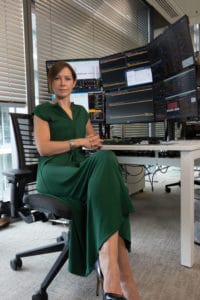 The market volatility stemming from the COVID-19 pandemic came as a challenge for many traders, but for Polar Capital’s recently-appointed head trader, Alex Jenkins, it presented a window of opportunity to showcase what a centralised trading desk can really do.
The market volatility stemming from the COVID-19 pandemic came as a challenge for many traders, but for Polar Capital’s recently-appointed head trader, Alex Jenkins, it presented a window of opportunity to showcase what a centralised trading desk can really do.
Having taken on the role in early December, Jenkins – much like all of us – could never have anticipated the global events that would ensue as she was tasked with building an internal trading desk that the investment firm’s portfolio managers can utilise. Polar Capital had recognised the lack of volatility that had loomed over markets for the past decade was unsustainable, and when the industry entered periods of market stress it would be favourable to have a wholly-focused execution desk in-house.
“Management understood that there were going to be huge benefits to having a trading desk when it came to key areas such as adapting to new regulation, accessing liquidity and helping manage execution costs, which have been more heavily scrutinised under MiFID II,” Jenkins says.
“It also gives the fund managers more time to focus on the fundamentals of their portfolios. There’s so much that they have to spend their time on and execution was part of that, but it wasn’t necessarily something they wanted to be doing. Fund managers have always had full autonomy over the investment process for their funds at Polar Capital, but while firm resources and infrastructure support the success of the investment teams; I think the trading desk was seen as an extension to that.”
Led by Jenkins, the newly-formed trading desk at Polar Capital operates on an opt-in basis for the investment firm’s fund managers, who have the full right to continue trading for themselves if they wish to. Jenkins explains this was a challenge as she began her new role, but the recent market volatility has provided her with a good opportunity to shine a light on the true value that an internal trading desk can deliver.
“I had to come in and establish those relationships quickly with the fund managers and almost sell what we could do for them. Thankfully, we’ve had amazing buy-in from them so far and even in this short period, we are already seeing the majority of trades going through the centralised desk,” Jenkins continues. “It has been a fantastic test for us over the past four months, and the portfolio managers have seen us as a great resource that has delivered. Hats off to management, I mean what amazing timing! I don’t think anyone predicted we would get the market volatility we’ve recently seen quite so quickly.”
Jenkins hasn’t always been on the buy-side. Like many others now trading for asset managers, her career began on the sell-side with Knight Capital as a European sales trader in 2007, covering institutions and hedge funds in European and US markets. Six years later, Jenkins moved to Cantor Fitzgerald in a similar role, before she was presented with an opportunity to move to the buy-side with Highbridge Capital, a former client that she worked closely with during her time on sell-side.
Highbridge Capital had decided to expand into London with a European desk, after establishing two new investment teams. Jenkins was tasked with overseeing trading for the European long/short book, which involved building new relationships, liaising with the high-touch desk, bringing in new electronic and conditional platforms, and working very closely with the compliance team in preparation for MiFID II, which would come into force in January 2018.
“It was a really great role because it was a mixture of everything,” Jenkins says. “I was able to build my experience across all areas of the business, and I found that extremely rewarding. I took a lot of the experience I gained on the sell-side and brought that into the buy-side trading role, which I would say was really valuable.
Just prior to her move to Polar Capital, Jenkins was also named a ‘Rising Star’ as part of The TRADE’s 2019 Rising Stars of Trading and Execution initiative, which aims to recognise up-and-coming buy-side trading talent.
“I was really lucky on the sell-side to cover some fantastic traders and that really helped me shape the sort of buy-side trader I wanted to be in the future, because I understood what I valued from clients when I was on the sell-side. The first few weeks on the buy-side I thought ‘what on earth have I done!’ But I grabbed the opportunity with both hands.”
 Preconceptions
Preconceptions
While her experience on the sell-side and building out the trading desk for Highbridge Capital will have proved useful for Jenkins’ move to Polar Capital, she reiterates that it’s not a ‘one size fits all’ for any firm. Over the course of the first month with the firm, Jenkins focused her attentions on understanding the long-established culture, as well as the vision and strategy of management at Polar Capital, and how to best deliver on those from her new seat.
As an immediate step, Jenkins implemented various procedures at Polar Capital to outline exactly how the new trading desk would work, how it would engage with the fund managers, meet regulatory requirements, and work orders. With 12 investment teams operating at Polar Capital, the focus then became figuring out how the trading desk can add value to those teams in varying ways.
“I came into this knowing that I didn’t want any preconceptions of what I wanted the trading desk to be,” Jenkins adds. “I wasn’t just looking to replicate what I had done at Highbridge Capital, it’s not a one size fits all. You have to give yourself a little time to think about what works for the place you work at. Polar Capital has a great family feel, and despite growing significantly, it has managed to keep that feel. There’s a great work ethic without losing the comradery, and there’s a strong sense that we are all in this together. I wanted to take that, the culture that Polar Capital has, and build it into the trading desk.
“We implemented some processes early on, and that will all be built on in time, but we didn’t want to do too much too soon. I wanted to make continued marginal gains, not take too many leaps forward, or have too many ideas of what I wanted it to be, because that would have been a disadvantage. It was about fully understanding the workflow, how busy we are in each region, and where we really need to focus our resources.”
In the time that Jenkins has been with Polar Capital, the firm has brought in an outsourced trading desk, added conditional venues and streamlined the low-touch products it uses to boost the data, which would be analysed via transaction cost analysis (TCA). One of the traders on the desk also has a knack for development, and has recently automated certain processes in terms of communicating with the fund managers.
There are currently three traders on the trading desk at Polar Capital, led by and including Jenkins. They currently trade Europe, US and Asia as an overnight market, the idea being that in the medium-term, as Jenkins unravels the nuances of the workflow, the trading desk will have enough resources to cover each region efficiently.
In the long-term, Jenkins plans to look at how technology and partnerships with FinTech vendors could further bolster processes for the investment firm. Having spent just three months in the office, and the following four months in lockdown due to the coronavirus pandemic, Jenkins reiterates that her primary focus is on ensuring the trading desk operates effectively in the current market environment to the advantage of the fund managers.
“I was in the seat three months before this new normal was established,” Jenkins continues. “Polar Capital reacted very quickly and started to split teams and move people to working from home even before the government officially announced the lockdown, given the infection rate. We needed to make sure we could cope with the systems and the new environment and our IT team were fundamental in making that happen. They didn’t just make it possible, they made it seamless. It’s times like that where you really start to understand how important it is to have solid teams around you.
“We knew throughout the lockdown that we needed consistency and communication, and that’s what made it work. We had continued communication with our portfolio managers, we continued to operate with our processes and ensured everything from systems to settlement were working properly.”
 Constant changes
Constant changes
Polar Capital has a good proportion of its £14 billion of assets under management invested in US equities, meaning Jenkins has been trading the US market a lot more than compared with her days as a European sales trader.
US markets, like most other markets globally, were not immune to the coronavirus. In mid-March to April, market volatility surged as the world tried to get to grips with new concepts such as a lockdown or furlough schemes, and confidence in businesses globally was tested.
Jenkins witnessed this first-hand, and says the industry has seen huge changes in the trading environment over the past three months. She outlines that spreads in S&P 500 were four times higher in March than they were in January, while market depth was 50% lower, and up to 75% lower in the last half hour of the day due to press conferences which took place at the White House every Friday during market hours. By mid-March, multiple exchange groups had also confirmed trading floor closures, and most across the industry were forced into remote trading environments.
“The constant changes were just incredible. It has been an extraordinary time. As a trader, it’s been a difficult and scary time for many, but it’s extremely interesting to go through volatile periods like this – we don’t get this very often.
“We had the closure of the New York Stock Exchange floor, which was such an abrupt end to something we had participated in every day. Following that, ADV at the close plummeted from around 15% in March to 7% in April. We were having to constantly and rapidly adapt to these changes. It meant you had to really think about how you traded, which algorithms you were using, what it meant to be passive and aggressive in the market. We worked with the portfolio managers continually to try and understand their investment thesis and what it was they were trying to achieve. An awful lot was thrown at us.”
As spreads widened and market depth plummeted, Jenkins also noted a significant pick-up in retail volumes while block liquidity dropped. With the likes of E-TRADE, Charles Schwab and Ameritrade now offering retail investors 0% commission, it was the perfect storm for retail brokers as a record number of investors signed up to brokerage apps and digital platforms to trade the volatile markets. Jenkins adds that for institutions, this trend is difficult to handle and forced large investors to adapt quickly to the new trading environment.
The retail ‘darlings’ of US markets (Apple, Amazon or Facebook) have seen huge amounts of retail volumes in recent months and much of that is internalised at wholesalers. This means that the amount of accessible volume for institutional investors in some of those names is in fact significantly lower than it looks on the tape. Jenkins explains that while the names remain liquid, the challenge is facing a different trading environment each time. Elsewhere, and perhaps more importantly, the volatility presented an opportunity to truly test the market infrastructure.
“There were rumours at times that the market would close, which is just astounding,” Jenkins continues. “I think it was very important that they stayed open. People should always have the ability to take their cash out of the market if they want to. We learned a huge amount about the market infrastructure, which we wouldn’t have learned if the market had been closed. We know now that it can stand up to volatility, and circuit breakers have been tested and they work – that’s important because the index circuit breakers hadn’t been triggered yet. I think this has given us all comfort about the infrastructure we were operating in. We know going forward that if this is to happen again, when it happens again, the infrastructure works.”
Jenkins explains Polar Capital saw no issues with its algo stacks throughout the entire experience, and electronic providers worked to continually adapt to the firm’s processes, and customise certain areas. Moreover, relationships with the sell-side have become even more important, both high and low-touch.
Much like the buy-side, banks and brokers also implemented business continuity plans which involved much of their workforce trading from homes or backup sites. Jenkins praises the sell-side and their ability to provide extensive and valuable data during the crisis, which would allow her and the trading desk at Polar Capital to analyse the new trading environment, whether that be driven by shifts in retail volumes or the closure of NYSE’s trading floor.
“It was imperative that we could rely on the sell-side, and they deserve huge praise for the work they have done during this period. The brokers were in the same position as everyone, but had to move entire trading floors across all of their asset classes to working from home. Honestly, they didn’t skip a beat. They were even doing calls on Sunday nights to make sure we understood what was happening.”
The volatility isn’t quite over yet, and Polar Capital’s decision to bring Jenkins on board to establish a centralised trading desk could not have come at a better time. As markets globally continue to react to the potential of a second wave of coronavirus, it is understandable that asset managers with an efficient internal trading desk may rest a little easier knowing that their now experienced traders have things in hand.